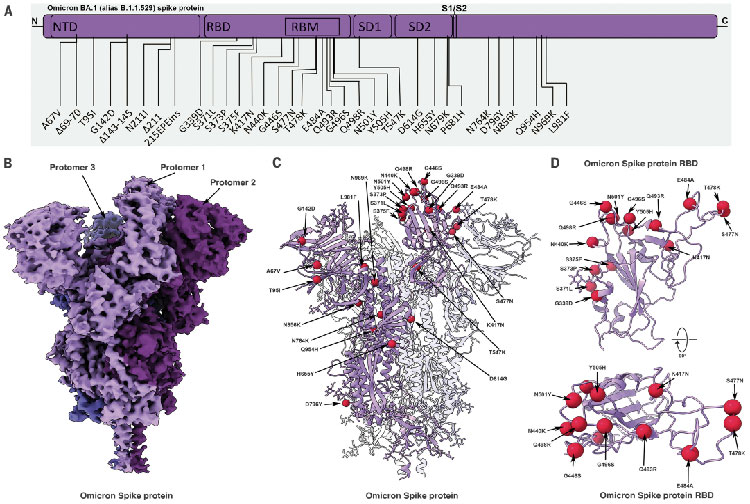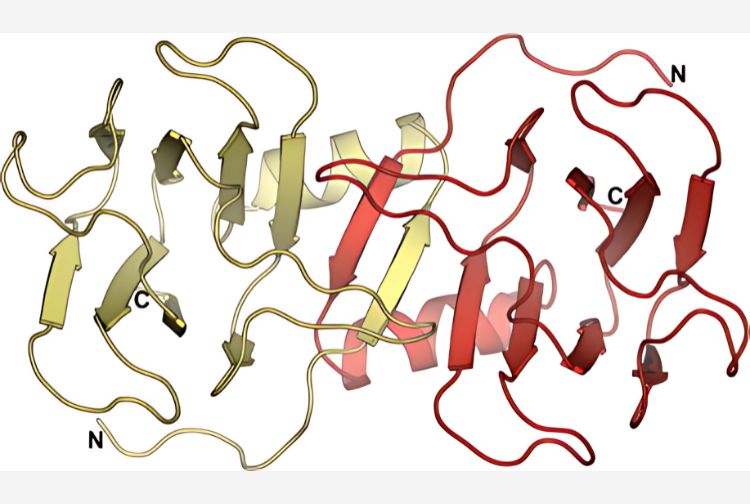Publications

Mannar, Saville, Zhu, Srivastava, Berezuk, Tuttle, Marquez, Sekirov, and Subramaniam present the cryo-EM structure of the SARS-CoV-2 Omicron variant spike protein bound to human ACE2, revealing how mutations allow antibody evasion and maintain receptor binding. This study offers insight into Omicron’s rapid spread and immune resistance.

Authors: Xing Zhu, Dhiraj Mannar, Shanti S. Srivastava, Alison M. Berezuk, Jean-Philippe Demers, James W. Saville, Karoline Leopold, Wei Li, Dimiter S. Dimitrov, Katharine S. Tuttle, Steven Zhou, Sagar Chittori, Sriram Subramaniam. This 2.9-Å cryo-EM study reveals N501Y’s interaction with ACE2, enhancing infectivity without compromising antibody binding.

Authors: James W. Saville, Dhiraj Mannar, Xing Zhu, Shanti S. Srivastava, Alison M. Berezuk, Jean-Philippe Demers, Steven Zhou, Katharine S. Tuttle, Inna Sekirov, Andrew Kim, Wei Li, Dimiter S. Dimitrov, Sriram Subramaniam. This study evaluates the Delta and Kappa variants’ structural and biochemical fitness, highlighting their antibody escape mechanisms and ACE2 binding dynamics.

Authors: Dhiraj Mannar, James W. Saville, Xing Zhu, Shanti S. Srivastava, Alison M. Berezuk, Steven Zhou, Katharine S. Tuttle, Andrew Kim, Wei Li, Dimiter S. Dimitrov, Sriram Subramaniam. This study investigates key mutations in SARS-CoV-2 variants that enhance ACE2 binding and promote antibody evasion through structural analyses.

Authors: Dhiraj Mannar, James W. Saville, Zehua Sun, Xing Zhu, Michelle M. Marti, Shanti S. Srivastava, Alison M. Berezuk, Steven Zhou, Katharine S. Tuttle, Michele D. Sobolewski, Andrew Kim, Benjamin R. Treat, Priscila Mayrelle Da Silva Castanha, Jana L. Jacobs, Simon M. Barratt-Boyes, John W. Mellors, Dimiter S. Dimitrov, Wei Li, Sriram Subramaniam. This study explores neutralization by antibody fragment VH ab6 against major SARS-CoV-2 variants, revealing structural insights into spike mutations and antibody evasion.

Authors: Shanti Swaroop Srivastava, Amita Mishra, Bal Krishnan, Yogendra Sharma. This study investigates the βγ-crystallin-type double clamp motif for Ca2+ binding, highlighting its structural diversity and potential functional implications.

Authors: Amita Mishra, Bal Krishnan, Shanti Swaroop Srivastava, Yogendra Sharma. This review highlights microbial βγ-crystallins as a diverse superfamily of Ca2+-binding proteins, noting their evolutionary adaptations and the need for experimental characterization.

Authors: James W Saville, Alison M Berezuk, Shanti S Srivastava, Sriram Subramaniam. This review details structural biology and pathobiology of SARS-CoV-2, focusing on its life cycle and imaging techniques that advance our understanding of viral entry and replication.

Authors: Amita Mishra, Shashi Kumar Suman, Shanti S Srivastava, Rajan Sankaranarayanan, Yogendra Sharma. This study analyzes Ca²⁺ binding in βγ-crystallin motifs, identifying binding determinants and stability gains through detailed structural investigations.

Authors: V. Rajanikanth, Shanti Swaroop Srivastava, Aditya K. Singh, M. Rajyalakshmi, Kousik Chandra, Penmatsa Aravind, Rajan Sankaranarayanan, Yogendra Sharma. This study investigates the unfolding pathways of βγ-crystallins and the formation of an aggregation-prone intermediate state in the Crybg3_D3 domain, offering insights into its structural and functional divergence in non-lens tissues of vertebrates.

Authors: Shanti Swaroop Srivastava, Joseph E. Darling, Jimmy Suryadi, James C. Morris, Mark E. Drew, Sriram Subramaniam. This study reports cryo-EM structures of Plasmodium vivax hexokinase (PvHK), revealing a unique tetrameric organization that is distinct from human hexokinases, providing insights for the design of parasite-selective antimalarial drugs.

Authors: Xing Zhu, Dhiraj Mannar, Shanti Swaroop Srivastava, Alison Berezuk, Jean-Philippe Demers, James Saville, Karoline Leopold, Wei Li, Dimiter S Dimitrov, Katharine Tuttle, Steven Zhou, Sagar Chittori, Sriram Subramaniam. This study presents a cryo-EM structure of the N501Y spike protein of the UK variant of SARS-CoV-2, showing how the mutation increases infectivity while retaining neutralizing antibody binding sites.

Authors: Shanti Swaroop Srivastava, Aditya Anand Jamkhindikar, Rajeev Raman, Maroor K. Jobby, Swathi Chadalawada, Rajan Sankaranarayanan, Yogendra Sharma. This study reveals that Methallin, a βγ-crystallin from Methanosaeta thermophila, is a trimeric, transition metal-binding protein, providing new insights into its potential biogeochemical roles and high-affinity metal ion binding.

Authors: Bal Krishnan, Shanti Swaroop Srivastava, Venu Sankeshi, Rupsi Garg, Sudhakar Srivastava, Rajan Sankaranarayanan, Yogendra Sharma. This study explores the role of a βγ-crystallin domain in modulating the enzymatic activity of a glycoside hydrolase, glucanallin, and its potential application in biofuel production from β-1,3-glucans.

Authors: Shanti Swaroop Srivastava, Rajeev Raman, Uday Kiran, Rupsi Garg, Swathi Chadalawada, Asmita D. Pawar, Rajan Sankaranarayanan, Yogendra Sharma. This study investigates how interdomain interactions in the abundant perithecial protein (APP) of *Neurospora crassa* render its Ca2+-binding site inactive, revealing a novel mode of Ca2+-binding regulation in proteins with both βγ-crystallin and Ig-like domains.

Authors: Wei Li, Alexandra Schäfer, Swarali S. Kulkarni, Xianglei Liu, David R. Martinez, Chuan Chen, Zehua Sun, Sarah R. Leist, Aleksandra Drelich, and others. A novel human antibody domain, VH ab8, was developed showing strong neutralizing effects against SARS-CoV-2 in mice and hamsters. Its small size and bivalency made it highly effective in targeting the virus and blocking ACE2 interaction, positioning it as a promising COVID-19 therapeutic.
Copyright © SSS Lab